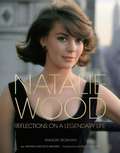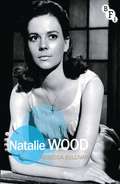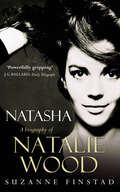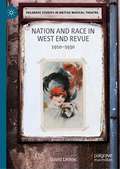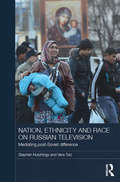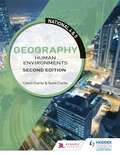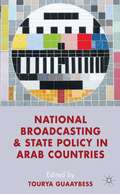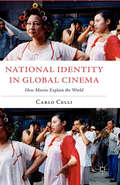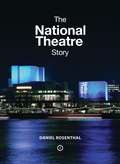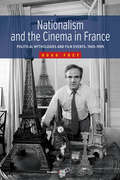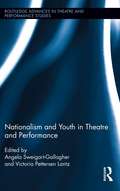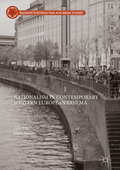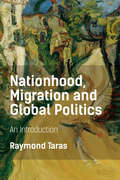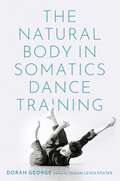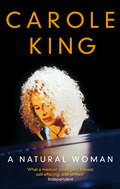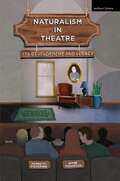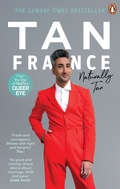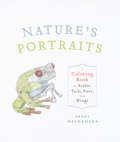- Table View
- List View
Natalie Wood: Reflections on a Legendary Life (Turner Classic Movies)
by Manoah BowmanManoah Bowman is the author of Fellini: The Sixties.He maintains the Independent Visions photographic archives, a collection featuring more than a million unique images that details the history of cinema and television. He has contributed material to many publications, movie studios, and museums, including Eastman House, the Academy of Motion Picture Arts and Sciences,Paramount, and Disney. His work as a photo editor includes the books Chaplin: Genius of the Cinema and Buster Keaton Remembered. He resides in Los Angeles, CA.Natasha Gregson Wagner has led an unorthodox career for the descendent of Hollywood royalty. Since making her film debut in 1992's Fathers and Sons, the actress established her place in the indie film world with titles such asAnother Day in Paradise, High Fidelity, Two Girls and a Guy,, and David Lynch's Lost Highway, and she has received acclaim for her stage work and television appearances in Ally McBeal, House MD, and Chicago Hope. She recently completed work on the independent film Anesthesia. Wagner resides in Los Angeles.
Natalie Wood: Reflections on a Legendary Life (Turner Classic Movies)
by Manoah Bowman Turner Classic MoviesAs a child actor who smoothly transitioned to adult stardom, Natalie Wood made an unforgettable impact on the world with her sensitive performances and her spectacular beauty. In a span of less than twenty years, her talent graced a dozen classics, including Miracle on 34th Street, The Searchers, Rebel Without a Cause, Splendor in the Grass, West Side Story, and Gypsy, earning her three Oscar nominations and two Golden Globes. Few actresses in Hollywood history have carved out careers as diverse and rich as Natalie Wood's, and few have touched as many hearts in a tragically short lifetime.Natalie Wood: Reflections on a Legendary Life boldly redefines Natalie not by her tragic death, but by her extraordinary life. This is the first family-authorized photographic study of Natalie Wood, and the first book to examine her glamorous film career as well as her private off-screen life as a wife and mother. Highlights include a special section on the making of West Side Story, a foreword by her husband Robert Wagner, a family album with never-before-seen snapshots captioned by daughter Courtney Wagner, an unpublished article written by Natalie in her own words, and an afterword by friend and costar Robert Redford. Natalie Wood: Reflections on a Legendary Life will change the way the world remembers a Hollywood legend.
Natalie Wood (Film Stars)
by Rebecca SullivanThroughout her career, Natalie Wood teetered precariously on the edge of greatness. Trained in the classical Hollywood studio style, but best mentored by Method directors, Wood was the ideal actress for roles depicting shifting perceptions of American womanhood. Nonetheless, while many of her films are considered classics of mid-twentieth century American cinema, she is less remembered for her acting than she is for her mysterious and tragic death. Rebecca Sullivan's lucid and engaging study of Natalie Wood's career sheds new light on her enormous, albeit uneven, contributions to American cinema. This persuasive text argues for renewed appreciation of Natalie Wood by situating her enigmatic performances in the context of a transforming star industry and revolutionary, post-war sexual politics.
Natasha: The Biography of Natalie Wood
by Suzanne FinstadBorn Natasha Zakharenko, Natalie Wood continues to haunt us 20 years after her tragic and mysterious death. Her dark hypnotic beauty and passionate performances made her a movie star legend, appearing in over fifty films including West Side Story and Rebel Without a Cause for which she was Oscar nominated. The story of her life is tinged with tragedy and drama. Pushed by her domineering, frustrated mother - an alcoholic determined to make her child a star at whatever cost, Natalie grew up fast - lonely and a misfit, uncertain of her identity. At fifteen she had embarked on an affair with a director 30 years her senior, she was brutally raped by a leading Hollywood star when she was sixteen -an attack which her mother forbade her to report. Her leading men frequently became her lovers including Elvis Presley, James Dean , Warren Beatty and the real love of her life, Robert Wagner whom she eventually married twice. Her fear of being alone and the years of exploitation and abuse led to an addiction to sleeping pills and several suicide attempts and for the first time, this book looks at evidence, yet to be published, surrounding her premature and controversial death - drowning at the age of 43. Suzanne Finstad has spent 3 years researching this, the first substantive biography of Natalie Wood, conducting over 400 interviews with friends, family, lovers, co-stars and the police officials who investigated her death.
Nation and Race in West End Revue: 1910–1930 (Palgrave Studies in British Musical Theatre)
by David LintonLondon West End revue constituted a particular response to mounting social, political, and cultural insecurities over Britain’s status and position at the beginning of the twentieth century. Insecurities regarding Britain’s colonial rule as exemplified in Ireland and elsewhere, were compounded by growing demands for social reform across the country — the call for women’s emancipation, the growth of the labour, and the trade union movements all created a climate of mounting disillusion. Revue correlated the immediacy of this uncertain world, through a fragmented vocabulary of performance placing satire, parody, social commentary, and critique at its core and found popularity in reflecting and responding to the variations of the new lived experiences. Multidisciplinary in its creation and realisation, revue incorporated dance, music, design, theatre, and film appropriating pre-modern theatre forms, techniques, and styles such as burlesque, music hall, pantomime, minstrelsy, and pierrot. Experimenting with narrative and expressions of speech, movement, design, and sound, revue displayed ambivalent representations that reflected social and cultural negotiations of previously essentialised identities in the modern world. Part of a wide and diverse cultural space at the beginning of the twentieth century it was acknowledged both by the intellectual avant-garde and the workers theatre movement not only as a reflexive action, but also as an evolving dynamic multidisciplinary performance model, which was highly influential across British culture. Revue displaced the romanticism of musical comedy by combining a satirical listless detachment with a defiant sophistication that articulated a fading British hegemonic sensibility, a cultural expression of a fragile and changing social and political order.
Nation, Ethnicity and Race on Russian Television: Mediating Post-Soviet Difference (BASEES/Routledge Series on Russian and East European Studies)
by Stephen Hutchings Vera TolzRussia, one of the most ethno-culturally diverse countries in the world, provides a rich case study on how globalisation and associated international trends are disrupting, and causing the radical rethinking of approaches to, inter-ethnic cohesion. The book highlights the importance of television broadcasting in shaping national discourse and the place of ethno-cultural diversity within it. It argues that television’s role here has been reinforced, rather than diminished, by the rise of new media technologies. Through an analysis of a wide range of news and other television programmes, the book shows how the covert meanings of discourse on a particular issue can diverge from the overt significance attributed to it, just as the impact of that discourse may not conform with the original aims of the broadcasters. The book discusses the tension between the imperative to maintain security through centralised government and overall national cohesion that Russia shares with other European states, and the need to remain sensitive to, and to accommodate, the needs and perspectives of ethnic minorities and labour migrants. It compares the increasingly isolationist popular ethnonationalism in Russia, which harks back to "old-fashioned" values, with the similar rise of the Tea Party in the United States and the UK Independence Party in Britain. Throughout, this extremely rich, well-argued book complicates and challenges received wisdom on Russia’s recent descent into authoritarianism. It points to a regime struggling to negotiate the dilemmas it faces, given its Soviet legacy of ethnic particularism, weak civil society, large native Muslim population and overbearing, yet far from entirely effective, state control of the media.
Nation, Ethnicity and Race on Russian Television: Mediating Post-Soviet Difference (BASEES/Routledge Series on Russian and East European Studies)
by Stephen Hutchings Vera TolzRussia, one of the most ethno-culturally diverse countries in the world, provides a rich case study on how globalisation and associated international trends are disrupting, and causing the radical rethinking of approaches to, inter-ethnic cohesion. The book highlights the importance of television broadcasting in shaping national discourse and the place of ethno-cultural diversity within it. It argues that television’s role here has been reinforced, rather than diminished, by the rise of new media technologies. Through an analysis of a wide range of news and other television programmes, the book shows how the covert meanings of discourse on a particular issue can diverge from the overt significance attributed to it, just as the impact of that discourse may not conform with the original aims of the broadcasters. The book discusses the tension between the imperative to maintain security through centralised government and overall national cohesion that Russia shares with other European states, and the need to remain sensitive to, and to accommodate, the needs and perspectives of ethnic minorities and labour migrants. It compares the increasingly isolationist popular ethnonationalism in Russia, which harks back to "old-fashioned" values, with the similar rise of the Tea Party in the United States and the UK Independence Party in Britain. Throughout, this extremely rich, well-argued book complicates and challenges received wisdom on Russia’s recent descent into authoritarianism. It points to a regime struggling to negotiate the dilemmas it faces, given its Soviet legacy of ethnic particularism, weak civil society, large native Muslim population and overbearing, yet far from entirely effective, state control of the media.
National 4 & 5 Geography: Second Edition (PDF)
by Calvin Clarke Susie ClarkeExam Board: SQA Level: National 5 Subject: Geography First Teaching: September 2017 First Exam: Summer 2018 This second edition now includes N5 examination-style questions, together with detailed advice on answering them, as well as exemplar answers, included for every topic. - Comprehensive coverage of the Human Environment elements in National 4 and 5 Geography - End-of-chapter questions for each topic at N4 and N5 levels
National Broadcasting and State Policy in Arab Countries
by Tourya GuaaybessA state-of-the-art analysis of the situation of national television in Arab countries, addressing what Arab national broadcastings today say about public policy and political opening. The essays deal with the reforms of public broadcasting organizations and the evolution, perspectives and issues of national broadcasting.
National Identity in 21st-Century Cuban Cinema: Screening the Repeating Island
by Dunja FehimovićNational Identity in 21st-Century Cuban Cinema tours early 21st-century Cuban cinema through four key figures—the monster, the child, the historic icon, and the recluse—in order to offer a new perspective on the relationship between the Revolution, culture, and national identity in contemporary Cuba. Exploring films chosen to convey a recent diversification of subject matters, genres, and approaches, it depicts a changing industrial landscape in which the national film institute (ICAIC) coexists with international co-producers and small, ‘independent’ production companies. By tracing the reappearance, reconfiguration, and recycling of national identity in recent fiction feature films, the book demonstrates that the spectre of the national haunts Cuban cinema in ways that reflect intensified transnational flows of people, capital, and culture. Moreover, it shows that the creative manifestations of this spectre screen—both hiding and revealing—a persistent anxiety around Cubanness even as national identity is transformed by connections to the outside world.
National Identity in 21st-Century Cuban Cinema: Screening the Repeating Island
by Dunja FehimovićNational Identity in 21st-Century Cuban Cinema tours early 21st-century Cuban cinema through four key figures—the monster, the child, the historic icon, and the recluse—in order to offer a new perspective on the relationship between the Revolution, culture, and national identity in contemporary Cuba. Exploring films chosen to convey a recent diversification of subject matters, genres, and approaches, it depicts a changing industrial landscape in which the national film institute (ICAIC) coexists with international co-producers and small, ‘independent’ production companies. By tracing the reappearance, reconfiguration, and recycling of national identity in recent fiction feature films, the book demonstrates that the spectre of the national haunts Cuban cinema in ways that reflect intensified transnational flows of people, capital, and culture. Moreover, it shows that the creative manifestations of this spectre screen—both hiding and revealing—a persistent anxiety around Cubanness even as national identity is transformed by connections to the outside world.
National Identity in Global Cinema: How Movies Explain the World
by C. CelliWhen themes of historical and cultural identity appear and repeat in popular film, it is possible to see the real pulse of a nation and comprehend a people, their culture and their history. National Identity in Global Cinema describes how national cultures as reflected in popular cinema can truly explain the world, one country at a time.
The National Theatre Story
by Daniel RosenthalThe National Theatre Story is filled with artistic, financial and political battles, onstage triumphs – and the occasional disaster.This definitive account takes readers from the National Theatre’s 19th-century origins, through false dawns in the early 1900s, and on to its hard-fought inauguration in 1963. At the Old Vic, Laurence Olivier was for ten years the inspirational Director of the NT Company, before Peter Hall took over and, in 1976, led the move into the National’s concrete home on the South Bank. Altogether, the NT has staged more than 800 productions, premiering some of the 20th and 21st centuries’ most popular and controversial plays, including Amadeus, The Romans in Britain, Closer, The History Boys, War Horse and One Man, Two Guvnors. Certain to be essential reading for theatre lovers and students, The National Theatre Story is packed with photographs and draws on Daniel Rosenthal’s unprecedented access to the National Theatre’s own archives, unpublished correspondence and more than 100 new interviews with directors, playwrights and actors, including Olivier’s successors as Director (Peter Hall, Richard Eyre, Trevor Nunn and Nicholas Hytner), and other great figures from the last 50 years of British and American drama, among them Edward Albee, Alan Bennett, Judi Dench, Michael Gambon, David Hare, Tony Kushner, Ian McKellen, Diana Rigg, Maggie Smith, Peter Shaffer, Stephen Sondheim and Tom Stoppard.
Nationalism and the Cinema in France: Political Mythologies and Film Events, 1945-1995
by Hugo FreyIt is often taken for granted that French cinema is intimately connected to the nation’s sense of identity and self-confidence. But what do we really know about that relationship? What are the nuances, insider codes, and hidden history of the alignment between cinema and nationalism? Hugo Frey suggests that the concepts of the ‘political myth’ and ‘the film event’ are the essential theoretical reference points for unlocking film history. Nationalism and the Cinema in France offers new arguments regarding those connections in the French case, examining national elitism, neo-colonialism, and other exclusionary discourses, as well as discussing for the first time the subculture of cinema around the extreme right Front National. Key works from directors such as Michel Audiard, Jean-Luc Godard, Jean-Pierre Melville, Marcel Pagnol, Jean Renoir, Jacques Tati, François Truffaut, and others provide a rich body of evidence.
Nationalism and Youth in Theatre and Performance (Routledge Advances in Theatre & Performance Studies)
by Victoria Pettersen Lantz Angela Sweigart-GallagherNationalism and Youth in Theatre and Performance explores how children and young people fit into national political theatre and, moreover, how youth enact interrogative, patriotic, and/or antagonistic performances as they develop their own relationship with nationhood. Children are often seen as excluded from public discourse or political action. However, this idea of exclusion is false both because adults place children at the center of political debates (with the rhetoric of future generations) and because children actively insert themselves into public discourse. Whether performing a national anthem for visiting heads of state, creating a school play about a country’s birth, or marching in protest of a change in public policy, young people use theatre and performance as a means of publicly staking a claim in national politics, directly engaging with ideas of nationalism around the world. This collection explores the issues of how children fit into national discourse on international stages. The authors focus on national performances by/for/with youth and examine a wide range of performances from across the globe, from parades and protests to devised and traditional theatre. Nationalism and Youth in Theatre and Performance rethinks how national performance is defined and offers previously unexplored historical and theoretical discussions of political youth performance.
Nationalism and Youth in Theatre and Performance (Routledge Advances in Theatre & Performance Studies)
by Angela Sweigart-Gallagher Victoria Pettersen LantzNationalism and Youth in Theatre and Performance explores how children and young people fit into national political theatre and, moreover, how youth enact interrogative, patriotic, and/or antagonistic performances as they develop their own relationship with nationhood. Children are often seen as excluded from public discourse or political action. However, this idea of exclusion is false both because adults place children at the center of political debates (with the rhetoric of future generations) and because children actively insert themselves into public discourse. Whether performing a national anthem for visiting heads of state, creating a school play about a country’s birth, or marching in protest of a change in public policy, young people use theatre and performance as a means of publicly staking a claim in national politics, directly engaging with ideas of nationalism around the world. This collection explores the issues of how children fit into national discourse on international stages. The authors focus on national performances by/for/with youth and examine a wide range of performances from across the globe, from parades and protests to devised and traditional theatre. Nationalism and Youth in Theatre and Performance rethinks how national performance is defined and offers previously unexplored historical and theoretical discussions of political youth performance.
Nationalism in Contemporary Western European Cinema (Palgrave European Film and Media Studies)
by James HarveyThis book investigates screen representations of 21st century nationalism—arguably the most urgent and apparent phenomenon in the Western world today. The chapters explore recurrent thematic and stylistic features of 21st century western European cinema, and analyse the ways in which film responds to contemporary developments of mounting tensions and increasing hostilities to difference. The collection blends incisive sociological and historical engagement with close textual analysis of many types of screen media, including popular cinema, art-house productions, low-budget independent work, documentary and video installation. Identifying motifs of nationhood and indigeneity throughout, the contributors of this volume present important perspectives and a timely cultural response to the contemporary moment of nationalism.
Nationalism in Contemporary Western European Cinema (PDF)
by James HarveyThis book investigates screen representations of 21st century nationalism—arguably the most urgent and apparent phenomenon in the Western world today. The chapters explore recurrent thematic and stylistic features of 21st century western European cinema, and analyse the ways in which film responds to contemporary developments of mounting tensions and increasing hostilities to difference. The collection blends incisive sociological and historical engagement with close textual analysis of many types of screen media, including popular cinema, art-house productions, low-budget independent work, documentary and video installation. Identifying motifs of nationhood and indigeneity throughout, the contributors of this volume present important perspectives and a timely cultural response to the contemporary moment of nationalism.
Nationhood, Migration and Global Politics: An Introduction
by Raymond TarasUses philosophical thinking on delayed cinema, time and ethics to provide a new approach to reading film
The Natural Body in Somatics Dance Training
by Doran GeorgeFrom its beginnings as an alternative and dissident form of dance training in the 1960s, Somatics emerged at the end of the twentieth century as one of the most popular and widespread regimens used to educate dancers. It is now found in dance curricula worldwide, helping to shape the look and sensibilities of both dancers and choreographers and thereby influencing much of the dance we see onstage worldwide. One of the first books to examine Somatics in detail and to analyse how and what it teaches in the dance studio, The Natural Body in Somatics Dance Training considers how dancers discover and assimilate new ways of moving and also larger cultural values associated with those movements. The book traces the history of Somatics, and it also details how Somatics developed in different locales, engaging with local politics and dance histories so as to develop a distinctive pedagogy that nonetheless shared fundamental concepts with other national and regional contexts. In so doing it shows how dance training can inculcate an embodied politics by guiding and shaping the experience of bodily sensation, constructing forms of reflexive evaluation of bodily action, and summoning bodies into relationship with one another. Throughout, the author focuses on the concept of the natural body and the importance of a natural way of moving as central to the claims that Somatics makes concerning its efficacy and legitimacy.
NATURAL BODY SOMATICS DANCE TRAINING C
by Doran GeorgeFrom its beginnings as an alternative and dissident form of dance training in the 1960s, Somatics emerged at the end of the twentieth century as one of the most popular and widespread regimens used to educate dancers. It is now found in dance curricula worldwide, helping to shape the look and sensibilities of both dancers and choreographers and thereby influencing much of the dance we see onstage worldwide. One of the first books to examine Somatics in detail and to analyse how and what it teaches in the dance studio, The Natural Body in Somatics Dance Training considers how dancers discover and assimilate new ways of moving and also larger cultural values associated with those movements. The book traces the history of Somatics, and it also details how Somatics developed in different locales, engaging with local politics and dance histories so as to develop a distinctive pedagogy that nonetheless shared fundamental concepts with other national and regional contexts. In so doing it shows how dance training can inculcate an embodied politics by guiding and shaping the experience of bodily sensation, constructing forms of reflexive evaluation of bodily action, and summoning bodies into relationship with one another. Throughout, the author focuses on the concept of the natural body and the importance of a natural way of moving as central to the claims that Somatics makes concerning its efficacy and legitimacy.
A Natural Woman: A Memoir
by Carole KingA memoir by the iconic singer-songwriter chronicling her story from her beginnings in Brooklyn through her remarkable success as one of the world's most acclaimed musical talents, to her present day as a leading performer and activist. From her marriage to Gerry Goffin, with whom she wrote dozens of songs that hit the charts, to her own achievements, notably with 'Tapestry', which remained on the charts for more than six years, to her experiences as a mother, this memoir chronicles one of music's most successful and fascinating stars. The book includes dozens of photos from King's childhood, her own family, and behind-the-scenes images from her performances over the years.
Naturalism in Theatre: Its Development and Legacy
by Kenneth Pickering Jayne ThompsonAn accessible survey of the development of naturalism and its effects on modern-day theatre. Taking into account the philosophical, scientific and aesthetic ideas that constituted the movement during the nineteenth and early twentieth centuries, the book examines why naturalism is still a dominant mode of performance in theatre.
Naturally Tan: A Memoir
by Tan France'The book is meant to spread joy, personal acceptance, and most of all understanding. Each of us is living our own private journey, and the more we know about each other, the healthier and happier the world will be.'Growing up gay in a traditional South Asian family in South Yorkshire, Tan France could never have imagined he’d become part of a worldwide phenomenon. One of the few people of colour at his school, he experienced racist bullies, found solace at his grandad’s denim factory and eventually discovered his true calling at fashion college. Told with his trademark humour, for the first time Tan reveals the experiences that have made him the witty, compassionate man he is today.From meeting the love of his life Rob (a Mormon cowboy from Salt Lake City) to juggling three demanding businesses, Tan charts the highs and lows on his path to Queer Eye. And of course he can’t help but pepper this book with fashion dos and don’ts. Full of candid observations about US and UK cultural differences, celebrity encounters, and behind-the-scenes revelations about Queer Eye, Naturally Tan gives us Tan’s unique perspective on the happiness to be found in being yourself.
Nature's Portraits: A Coloring Book of Scales, Tails, Furs, and Wings
by Peggy MacnamaraWhen it comes to color, nothing can surpass the vast palette found in nature, from a bright green leaf in a sun-dappled forest to the rich red feathers of a cardinal and the muted greens, ambers, and browns that make up the shell of a tortoise. Wildlife artist Peggy Macnamara has been recreating the natural world through her drawings and paintings for decades, and, with Nature’s Portraits, she invites the rest of the world to join her. Nature’s Portraits offers sixty of Macnamara’s detailed drawings that can be brought brilliantly to life with nothing more than a few colored pencils or crayons and a sense of wonder about the world around us. Many of the drawings depict animals as they might appear in their natural habitats—like a tree frog, a dashing, playful fox, a snowy owl poised for flight, a sauntering jaguar, and a watchful herd of giraffe. These wild furry and feathered friends are joined by animals found in museums, including Sue, the Field Museum’s resident Tyrannosaurus rex. Each illustration is captioned with a brief scientific description of the species pictured. Combining inspiration from natural history with a calming, creative activity, Nature’s Portraits encourages us to take a closer look at what we miss when we don’t take the time to stop and look with deep appreciation at the bounty of the natural world around us.
